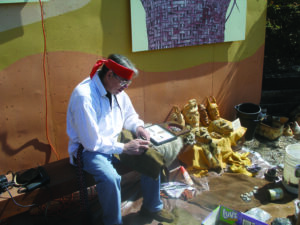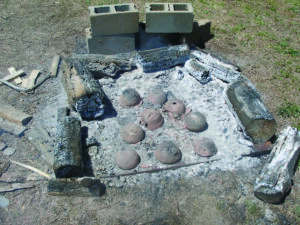HAYESVILLE – Western Carolina University students participated in a workshop held at the Cherokee Homestead Exhibit recently. Instruction was provided by Davy Arch, EBCI artist and historian; Clay County Communities Revitalization Association (CCCRA) and Far Western Gourd Patch member Sandy Nicolette; and Dr. Jane Eastman, WCU Department of Sociology and Anthropology.

EBCI artist Davy Arch demonstrates flint-knapping during a recent demonstration at the Cherokee Homestead Exhibit in Hayesville. (CCCRA photos)
Arch demonstrated flint knapping and mask making techniques. Under Arch’s supervision, the WCU students enjoyed practicing their flint knapping skills, after viewing Paleolithic tools donated to CCCRA by Mr. and Mrs. Robert Kappelmann and projectile points and stone tools donated by Doyce Waters.
Arch, an accomplished EBCI artisan and culturalist, has served on the boards of the North Carolina Arts Council and the Qualla Arts and Crafts Mutual, and works at the Oconaluftee Indian Village in Cherokee. He served as a primary consultant on the Cherokee Homestead Exhibit and assisted in artistic design for the public art at the exhibit.

Student pots are fired during a demonstration of Qualla Phase Pottery at the Cherokee Homestead Exhibit.
Under Nicolette’s direction, the students made a dipper out of a gourd they cut, cleaned and decorated. The students learned the various ways the Cherokee and other indigenous people used gourds, dating back thousands of years. Even with modern day tools, the students discovered how challenging it was to make a simple gourd dipper.
After studying the characteristics of Qualla Phase pottery, the students watched as Eastman fired their coiled pottery at the Exhibit site. Much to the students’ dismay, all of their pots cracked in some way. Developing a respect for the work of traditionally trained potters was another lesson learned at the workshop.
The workshop was sponsored by the Clay County Communities Revitalization Association and a grant provided by the Mary Duke Biddle Foundation.
The Cherokee Homestead Exhibit is a reconstructed 17th-18th century village homestead. It contains a Cherokee winter house, a summer house, food storage crib, multi-use structure, traditional Cherokee canoe, Cherokee garden and information kiosks. Public art includes hand-forged steel representations of Cherokee clan masks and iconic symbols of Cherokee culture and mythology, and wall-mounted panels depicting Cherokee artifacts, art and symbols. This free self-guided exhibit is open year-round. To learn more about past and upcoming events at the exhibit, visit www.cccra.net.
– CCCRA

